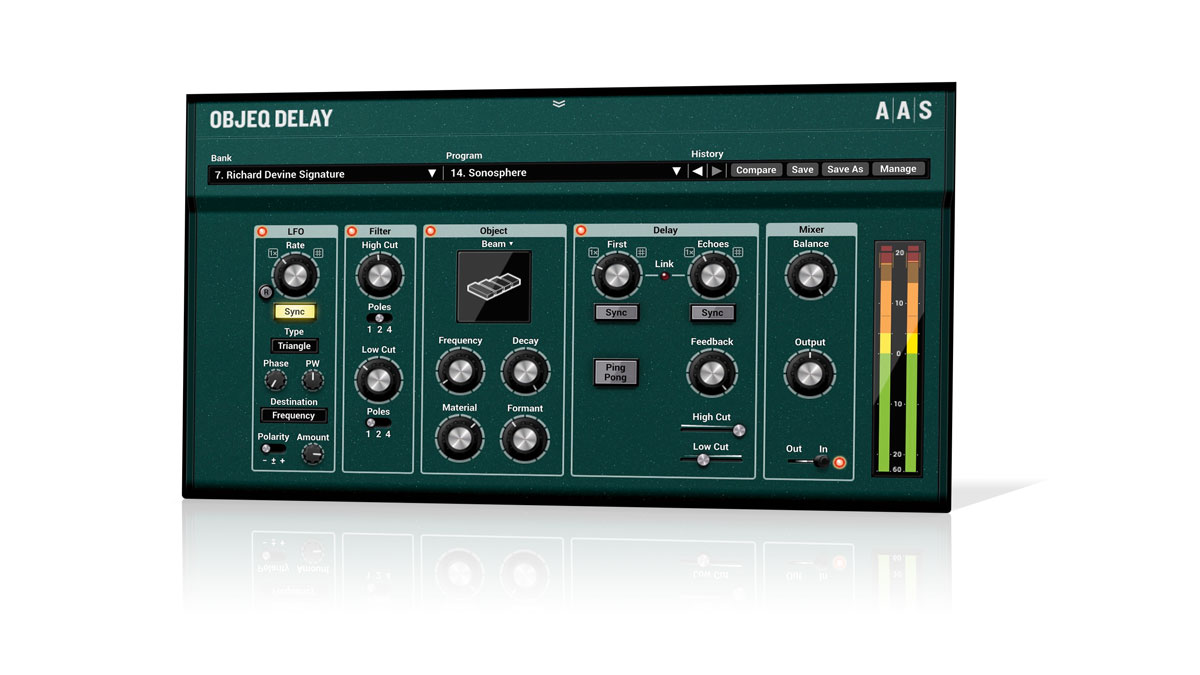MusicRadar Verdict
Objeq Delay’s combination of physical modelling synthesis and echo generation adds up to more than the sum of its parts.
Pros
- +
Excellent physical modeling.
- +
Powerful filters and LFO .
- +
Massive preset library.
Cons
- -
Not enough modulation.
- -
Delay section could be more ambitious.
- -
Object can’t process input and delays.
MusicRadar's got your back
AAS’ latest effect plugin (VST/AU/AAX) combines a stereo delay with the physical modelling synthesis for which the company is best known.
Comprising three individually bypassable signal processing sections, a final Mixer stage and an LFO for modulation, it enables transformation of the input signal or its echoes into tonally disparate sounds via one of four ‘acoustic resonators’.
Objeq of desire
The first stage in the signal flow is a pair of filters - High and Low Cut - each sweeping from 20Hz to 20kHz and offering a choice of 6dB, 12dB or 24dB/octave rolloff slopes.
After that comes the all-important Object section, where the acoustic resonators are brought into play, using complex filtering to make it sound as if the input is being merged with or ‘played through’ a particular type of physical medium.
When the Delay section is turned off, it processes the dry signal; when Delay is on, it works its magic on the wet signal only. It’s not possible to route the dry/wet mix through the Object, although a workaround is to use two instances of the plugin.
The four Object types are Beam (a solid, rectangular beam), Drumhead (a circular membrane), Plate (a flat, rectangular plate) and String (a “perfectly elastic” string). The specifics of the selected Object are highly tweakable, lending each one an impressively broad range in terms of spectrum and temporality.
Central to Objeq Delay’s sound design potential is its LFO. This can be assigned to cyclically modulate a single parameter from anywhere in the plugin, or the volume of the wet signal, which isn’t otherwise accessible. It’s got five waveshapes (Sine, Triangle, Square, Random and Random Ramp) and the same timing controls as the delay lines, but with the 2/3 and 4/3 Multipliers replaced by 3/4 and 3/2 options. The Polarity and Phase are adjustable, too, as is the Pulse Width, the last facilitating conversion of the Triangle wave to an up- or down-ramping saw, and shaping of the sine and square waves for lop- sided rhythmic variations.
The LFO is a fantastic and defining component of the plugin, but, oh, how we wish there was more than one of them, as wobbling that single, lonely parameter invariably inspires further, depressingly unrealisable modulation ideas. We’d take an envelope follower while they’re at it, an’ all.
The Frequency knob tunes the resonator’s fundamental pitch between 20Hz and 4kHz, while the time it takes to stop resonating is determined by the Decay knob. The Material control extends the decay of higher frequency partials the further clockwise its turned, with the effect of making the sound more metallic.
The Formant control adjusts the point at which the Object is ‘excited’ - ie, how close to the centre point it’s struck, expressed as a percentage: 0% is the outer edge, 100% is dead centre.
The final stage in the chain is the aforementioned Delay section, which contains two delay lines, the first (called, er, First) a simple tap, the second (Echoes) a feedback loop with sweepable 6dB/octave High and Low Cut filters inserted.
Each delay line can be run free at 0.001-8 seconds, or synced to host at the usual array of regular, dotted and triplet note timings; and the Multiply parameter scales the delay time by a factor of 1/2, 2/3, 4/3 or 2. There’s also a Ping Pong mode for left-to-right bouncing.
A world of its own
There simply isn’t another plugin on the market that does what Objeq Delay does, and its ability to generate percussive and melodic echo ‘sequences’ from any source material - as well as wonderfully odd spatialising, chorusing, flanging and more straightforward delay effects - is genuinely remarkable. It doesn’t hurt that the Object resonators sound superb, of course, or that a huge library of beautifully designed presets is included.
Beyond its limited modulation options (see Low Frequency Objeq), Objeq Delay’s only other significant failing is that the actual delay functionality is surprisingly basic - it’s positively crying out for a more creatively programmable multitap setup. Nonetheless, this is a unique and musically-minded plugin that every producer and sound designer needs to try.
Computer Music magazine is the world’s best selling publication dedicated solely to making great music with your Mac or PC computer. Each issue it brings its lucky readers the best in cutting-edge tutorials, need-to-know, expert software reviews and even all the tools you actually need to make great music today, courtesy of our legendary CM Plugin Suite.
“A synthesizer that is both easy to use and fun to play whilst maintaining a decent degree of programming depth and flexibility”: PWM Mantis review
“I feel like that song had everything we needed to come back with”: Bring Me The Horizon’s Lee Malia on Shadow Moses, its riff and the secrets behind its tone, and why it was the right anthem at the right time
“I said, ‘Are we sure we can write a song about death?’”: The story of Mike + The Mechanics' classic No.1 The Living Years











